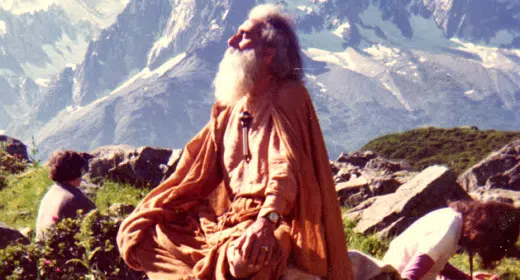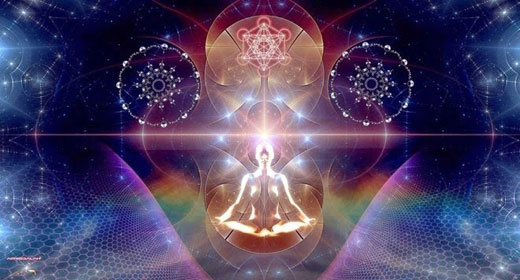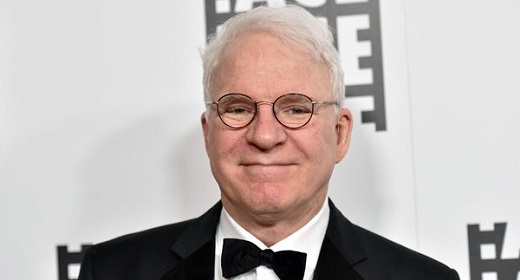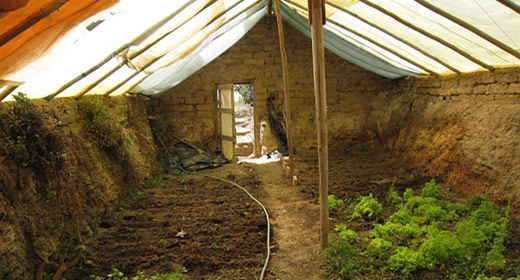Awaken: Pir Vilayat Inayat Khan, it is an honor to spend this time with you. I know our awakened readers will treasure your words.
 May we start with the question of awakening? What does this mean to you… to awaken?
May we start with the question of awakening? What does this mean to you… to awaken?
Pir Vilayat Inayat Khan: Seeing through the eyes of God… Sufis call this state of consciousness Jabarut, the ground out of which consciousness emerges. For as ordinary consciousness is gradually freed from the perspectives of every day existence — thoughts, ideas, circumstances, emotions, physical events — the transcendent dimension begins to emerge.
Awaken: What exactly do you mean by “transcendent?”
Pir Vilayat Inayat Khan: What do we mean by transcendence? Take, for example, an apple tree in Blossom. Though your glance takes in its trunk, branches, leaves, and flowers, you are also moved by its beauty and loveliness. And while the beauty of this tree depends upon its physical form, still, it has an essential reality of its own which is its meaningfulness.
Or, take music: behind the notes are an array of vibrational frequencies that could be said to constitute the language of the thinking of the universe. Likewise, it is the meaning – not the letters – that shine through the words of a book or text. So the mind, stripped of the distraction of transient thoughts, is infused with an inborn sense of meaningfulness. This transcendent faculty appears only once one has given up trying to sort things out in a habitual fashion.
Awaken: So, would you say that awakening is to see what was heretofore hidden?
Pir Vilayat Inayat Khan: in fact, according to the Qur’an, all that we perceive externally in the world of existence are signs, clues to the intention and meaningfulness lying just behind and beneath the surface of life. By shifting perspectives the way a child turns a kaleidoscope, we gradually see that all these perspectives are merely the veils over a concealed dimension of reality lying just beyond ordinary cognition.
Awaken: Please speak more about what it means to shift perspectives… Does this require what we may call a higher state of consciousness?
Pir Vilayat Inayat Khan: We become adept at learning to shift our consciousness from one perspective to another…
Awaken: So, it is a shift… and this shift represents spiritual awakening?
Pir Vilayat Inayat Khan: That is exactly what spiritual awakening is – shifting from one perspective to another, until we finally glimpse meaningfulness where our mind could not perceive it before. The higher and brighter the perspective, the more inclusive it is. The pictures we see in holograms extrapolate different vantage points because they involve the whole hologram rather than just a slice of it.
Awaken: For example?
Pir Vilayat Inayat Khan: When we look at our problems, for instance, we can see that there are different levels of meaning in our problems. We think we grasp what is being enacted in the problem; then we see that there is another level from which it looks entirely different — instantaneously something becomes clear to us, and we didn’t do anything! It’s totally impromptu, unexpected. We really have the feeling, “this was revealed to me.“
In this moment of revelation, it is as if the light of intelligence has enhanced the very aura surrounding our bodies. Just as when we grasp some thing that we’ve never understood before – suddenly there is a smile, an outburst of energy, and a breakthrough of light. One’s whole being burns with a brighter flame because of the intensity of awareness — as if the luminosity of our awareness has sparked the very cells of our body.
Awaken: And this series of sensations follows the awakening experience?
Pir Vilayat Inayat Khan: Indeed, awakening triggers off illumination; it is always connected to light. But it isn’t an intellectual process; it has to do with the radiance of luminous thoughts — a kind of clarity that overcomes ambiguity because light highlights things and makes everything clear.
Awaken: How does one best train oneself to be able to enjoy and benefit from this shift in consciousness?
Pir Vilayat Inayat Khan: Meditation and contemplation are the training grounds for moving between individual consciousness and cosmic consciousness, somewhat like the graduation of perspectives contained within a hologram. For example, you could think of the universe out there as “other“ and separate. Or, conversely, you could imagine that the cosmos has converged itself as your body and is looking at itself through your eyes. Experimenting with changes in our mode of thinking is what leads to the state of awakening called illumination by the mystics, just as discovering the cosmic and transcendent dimensions of our being broadens and transforms our formerly constricted understanding of life.
Awaken: But, can’t we begin to play with this, in an ordinary, every day setting in life… not solely through meditation, in the conventional sense?
Pir Vilayat Inayat Khan: One can begin working with altered states of consciousness by stepping back and observing how we ordinarily “see“ what goes on around us. Imagine, for a moment, that you are training your site upon a deeper reality that is transpiring behind the moving scene of every day life. You may be watching a rustic country scene, scanning the starry sky, or enjoying a glorious sunrise. You may be sipping coffee in a sidewalk caféon the Champs Élysées in Paris, observing life as it passes by; honking cars, men and women, young and old, intent on their business or casually dawdling. You may be watching a flight on 14th St. in New York City, observing a mugging in London, participating in political demonstrations in Italy, being moved by the wonder of a baby being born, or being saddened by a loved one dying.
Awaken: But there is another layer to all of this…
Pir Vilayat Inayat Khan: Behind this shifting panorama we may gradually begin to sense the larger emotions of the human drama: pain, cruelty, injustice, greed, terror, heroism, love, disenchantment. From yet another perspective, people seem inescapably conditioned, caught in the cogs of the wheels of a gigantic social power system which we call civilization. Or, if we tilt consciousness yet another way, the mass of humanity appears as ripples in an ever recurring flow of ongoing life.
Awaken: And yet, we must function in the real world… So, how do we reconcile the various levels of seeing? In other words, as this so-called higher level of seeing gives us a glimpse into another strata of reality, it’s a bit like having a secret but not being able to share it, isn’t it?
Pir Vilayat Inayat Khan: … To glimpse the true nature of the universe is like awakening from a clouded trance. “Imagine,” says Hazrat Inayat Khan, “that you were awake and walking about amongst people who sleep; how can you communicate with them? You realize that they have no idea about your awareness because they’re still sleeping. You used to be like that yourself. But now you are awake.” This is what Christ meant when he said, “They know not what they do.“
But witnessing the phenomenon of life from a transcendental overview doesn’t serve just to lift one up out of the trenches of existence. In the original Indian custom, people may leave the world to become ascetics. if that thinking is imported to the west without showing what light it can throw on peoples’ problems, it can make people otherworldly. Broadening our attunement beyond the horizons of the individual self, however, awakens one to the meaning encoded into existence — a kind of cognitive “super – logic” that reveals a different purpose, a larger pattern, than anything we might previously have imagined.
There is a story about Albert Einstein that illustrates this. It is said that he was pushing his baby in a pram in the midst of downtown New York City. As he was engaged in this seemingly mundane task, he was envisioning the planet whirling within the solar system, and the solar system whirling within the Milky Way — and so on, throughout the cosmos. Even in the crowded hustle and bustle of every day life, Einstein’s perspective allowed him to see himself within the context of the totality of this marvelous creation.
Awaken: Have you experienced this sensation, personally?
Pir Vilayat Inayat Khan: I remember… sitting in an ice cream parlor with my two little boys. I had just come out of a retreat and was feeling high because of my meditations. Then I thought to myself, “If only the people around me knew what they’re missing.” in another example, I recall making a visit to a rishi (Hindu mystic) who was in seclusion in a cave high up in the Himalayas. I was traveling with a group of people as it was a very dangerous jungle with lots of wild animals. One of the members of the group asked the rishi something that, to me, was very mundane. Fascinated, I watched the rishi struggle to come down from his state of divine ecstasy and enter into the mind of that person in order to answer his question.
Awaken: I want to dig deeper into the psychological, or should I say, spiritual mechanism that is at work in this shift of consciousness… for example, what is happening within, that engenders this deeper way of seeing?
Pir Vilayat Inayat Khan: How is this awesome task to be accomplished? To the Sufis, the answer lies in the transformation of consciousness that occurs as the result of a shift in perspective from the personal point of view to the divine point of view — what I called “thinking like the universe.”
Awaken: Yes! This is what I was after! Please continue…
Pir Vilayat Inayat Khan: Plato illustrated man’s ignorance by the allegory of the men chained in the cave who can see only shadows on the wall. In the same way, our everyday perspectives are illusory and therefore totally inadequate to making the quantum leap into a more evolved consciousness. We think, for instance, that it is the world that is our prison — whereas the prison is in our way of thinking and feeling. Caught in a vicious cycle of negativity that leads to despair, we give up any hope of being able to fulfill our ideals. Buddha, however, saw that the only way to break free of the mental chains that keep us bound in ignorance and misery is by attaining freedom from the personal “I“.
Awaken: Yes, he called it “avidya”… being caught up in the notion of a separate self.
Pir Vilayat Inayat Khan: The Sufis say those common place thoughts and opinions blur our innate connection to the divine. Eventually, as we view our problems through the eyes of the Universe, or God, we come to realize that what we think is our problem alone is the suffering of existence that is shared by everyone. It is as if we have been participating in the drama of the universe – yet all we have been able to think is “Why is this happening to me?“Indeed, if we keep adding more and more people, ad infinitum, in infinite regress, who share in the pain we think belongs exclusively to ourselves, then we begin to glimpse the reality behind the words of Saint Francis of Assissi when he said, “I thought I was looking at the world, but the world is looking at me.“
Awaken: Ahh yes, we get so easily ensnared by “victim consciousness”… but from a divine perspective, we can see above this, as well. Is that the take-away there?
Pir Vilayat Inayat Khan: Like Saint Francis, we cannot free ourselves from our identification with our individual self unless we open ourselves to the infinite dimension of the power of the sacred.
Awaken: And when you speak of the sacred, and of God… What is it that you mean?
Pir Vilayat Inayat Khan: This transcendent force is what some call God and what I also call the “Universe,” which may be the word which will be used at the millennium. Like a cosmic pull that exerts a force of its own over humanity, the Universe is constantly compelling us to break free of the conditioning of the past in order to transform and evolve. Just like the constant changes and adaptations in nature that have been occurring for aeons of time —resulting in emerald rainforests, exotic animals, and complex, intelligent creatures called people — this evolutionarily force functions like a spiritual magnet to draw humanity beyond its limitations into further dimensions of consciousness and levels of perception. Indeed, the impetus to span the cleft from the past to the future as part of an ongoing, billions-of-years-old process by which the Universe has been fashioning its stardust into human beings.
Awaken: This is the language of evolution… Is this to say that there is no “teleological” and determined plan underlying our existence? In other words, what about “destiny?” Or is that just a trite, common place notion?
Pir Vilayat Inayat Khan: Here we see the convergence of two forces: causality and continually recurrent emergence of creative new images and forms in the Universe — like the birth of a star. It is not determined. For example, what exactly do we mean by the concept of the “moment“ or “now“? If you are listening to music, the note you have just heard continues to resound in your ears, even as you begin to take in the next note. In this “moment“there are no boundaries between the past or the future. Thus Sufis do not see individuals as victims of an inexhaustibly pre-ordained fate, nor as autocratic masters of their individual destiny. Rather, they take into account the existence of a higher intelligence that, through an innovative, trial-and error, evolutionarily process, is embedded within humanity to creatively shape and reshape life in an endless array of new images, patterns, and paradigms.
Awaken: It is a coaction… an interplay between us and our creative spark that we have been endowed with, and this mysterious force that we are a part of?
Pir Vilayat Inayat Khan: It is out of the ever constant back-and-forth dialogue between these two poles that the future is created. I believe that the future is not just some thing waiting for us; it is something that is built by sorting through the past for that which belongs to tomorrow; it is a continual work-in-progress that takes place in every era and that occurs through each individual’s innovative, imaginative, and conscious participation.
Awaken: In very simple terms, we create the future? But yet this is a huge responsibility, and one that we haven’t completely accepted wholeheartedly, I dare say!
Pir Vilayat Inayat Khan: That the future is something we create, rather than passively endure, fills many with a sense of trepidation. To abandon the comfortable but worn out values of the past feels like a free fall into chaotic upheaval. But to fall back upon the comfort of the past, rather than move forward into the future, is to miss the rare cosmic opening that occurs in the flash of time between the past and the future in which it is possible to begin a new chapter in the evolving story of humankind.
Awaken: So, we do have the power to create and we are not helpless in a determined universe! But to couch what you are saying, squarely in the midst of every day life, I’d like to have you comment on how we can be effective creators, as awakened beings who want to live better individually, but who also want to create a better world… how do we better deal with our own problems and also deal with the problems that we are facing globally?
Pir Vilayat Inayat Khan: Can you imagine how your problems might look from God’s point of view, or envision how God might resolve them? Do you ever ask yourself what is the reason for the circumstances of your life? Have you ever considered the notion that those vexing dilemmas that plagued your daily life are challenging you to open to new ways of thinking? Can you sense how these difficulties are the means through which something mysterious, perhaps even great, is struggling to be born through you?
Awaken: I understand. You are saying to remember that rarefied vision that our meditations may bestow upon us, and to allow this to reshape our approach to every day problems?
Pir Vilayat Inayat Khan: Our meditations have borne us aloft toward the peaks of spiritual transcendence, where we have been granted a magnificent overview of all creation and insight into the mysteries of life. Now it is time to concentrate this overview upon the ordinary realm of every day life. For, as I have pointed out, awakening beyond life must be followed by awakening in life. At this level of realization, you are able to cast the light of the intelligence of the universe upon your problems instead of judging things the way they appear from your personal point of view.
Awaken: and so to make it very very clear, and to circle us right back around to the beginning, is this really the practical purpose of meditation?
Pir Vilayat Inayat Khan: The practical wisdom of meditation is to develop the skill of connecting to the real self now; the experience of immensity we are granted when we do so gives us the enormous power and resilience to face life‘s challenges. Hope opens up, as by turning within we are more likely to grasp the essence of the problem, instead of being caught by the way it appears at the surface. Through this insight, we can see the connection that exists between our problems and the way we have been approaching them. And once we see that, then we can also awaken to the realization that a transformation in consciousness can lead to a breakthrough in our problems.
Awaken: What is the greatest impediment toward this more enlightened approach to the everyday challenges of life?
Pir Vilayat Inayat Khan: Most of us, as we struggle through life, attempt to derive our strength solely from our self image as a separate ego — a source of weakness that ultimately compounds our problems. Especially when faced with an extremely challenging situation, there is a tendency to fall back on the ego, resorting to its inadequate strategies of defenses, denial, or wishful thinking. Only by recalling to mind the all embracing dimension of our higher being that is the divine ego and that we touch upon during peak moments of meditation can we begin to overcome the counterproductive tendencies of the personal self.
Awaken: It is to remember the sacred that serves as the key to this deeper perspective? Could you share an example of how the gift of seeing as God sees alters our experience of life?
Pir Vilayat Inayat Khan: I can tell you about an experience that I once had that describes the beauty and the outlook of the higher self. During a retreat that I was leading, an elderly lady went into a comatose state. She was dying and in a delirium. As I knelt down next to her, I held her hand in mine; even though she was in a coma she felt my presence. Her eyes fluttered open, and, in that moment, all her wrinkles disappeared. Before my eyes she became a young girl – radiant, full of light, and totally transfigured. My perception of her wasn’t fantasy, but her true countenance transpiring through her physical face.
Awaken: Beautiful… although, this isn’t really a “problem“ in the usual sense… How does the point apply?
Pir Vilayat Inayat Khan: It is our ignorance of this dimension of ourselves that causes our mishandling of the situation, resulting in suffering.
Awaken: In this example that you gave, I feel that a tremendous amount of compassion was applied to the situation, which makes it easier to connect to others, and this also has the effect of taking the edge off of life generally, doesn’t it? It’s a kind of heart-centered approach, where we literally feel the pain of others…
Pir Vilayat Inayat Khan: In fact, I often think the only way to deal with problems is to have a broken heart, to really feel broken about the suffering of people. I don’t mean to put yourself in the place of a therapist who want to help people, but rather to join in solidarity with the human condition and the depths of people’s despair and suffering. For you can help a person only if you’ve gone through the same problems he has gone through, and even if you have not solved them, you have found a way of living with them. Thus, what you find in the end of searching for solutions to your problems is really love, because love breaks your heart — and that is the only power that can truly expand your consciousness. Love casts a different perspective on the problem and the way it looks.
Awaken: Can you relay the simplest form of meditation, for those who don’t have the experience, but who may want to have a taste of it and maybe even begin with a simple practice?
Pir Vilayat Inayat Khan: As you watch thoughts take shape and rise in your mind, begin by observing the assumptions that lie behind them. For instance, when you say “my father,“ or, when you say that you are suffering, people think they understand what you mean. But your father is a relationship that carries with it a complex web of feelings, and your suffering is a relationship to specific situation, such as the despair that comes from feeling inadequate.
Awaken: I understand… you are saying that a thought isn’t really an isolated event, but that it comes anchored to our past experiences, associations, and stories that we have built around the subject of our thoughts…
Pir Vilayat Inayat Khan: Like an anchor dropped to the ocean floor, what this exercise does is to help shift your concentration from the periphery of consciousness to the depths of your being. This change is how you respond to conditions and disturbances arising in the outside world. Instead of reacting superficially, or cutting it out altogether, you respond from a very deep place inside yourself.
One of the best illustrations I have for explaining this dynamic is found in Beethoven’s fourth piano Concerto. With this piece, Beethoven portrays the world’s cry of agony through an orchestral movement. This is followed by one of the most beautiful piano melodies Beethoven ever composed.
To me, this was a musical expression of his deep response — rather than an automatic, reflexive reaction — to the world’s endless pain and suffering. His piano melody was a wordless response to the cries of agony from the depth of his being, rather than a mirror reaction from the periphery of his consciousness.
Awaken: Would you be willing to share any other stories from your own awakening journey that are dear to you?
Pir Vilayat Inayat Khan: I can tell you my own personal story of an encounter with a dervish. I was traveling in India in search of awakening when, having settled in for the night, I ordered tea and was told that someone would return right away with it – only to sit waiting as the hours passed. Finally, night arrived, and, giving up hope of a hot cup of tea, I put my sleeping bag on the floor and went to sleep. Then, in the middle of the night, a raucous voice screeched, and there was a loud pounding on the door. “Good God,” I thought — and went straight back to sleep. When my cup of tea finally arrived the next morning, I asked who had been shaking my door down, only to be told that a dervish had come to awaken me. The next night, when the same thing happened, I ran to the door but the dervish had already fled into the darkness. Just imagine, I came all the way to India to be awakened, and this time missed my chance.
The next day I traveled to the Dargah, or Memorial shrine, of the founder of the Chishti order… The enchantment of that tomb is incredible: it is a beautiful… people are all around, playing music, sleeping, or praying. The whole atmosphere is otherworldly. I was sitting there bemoaning the fact that I had missed my encounter with the dervish. Suddenly, behind me, I heard a voice say, “You there,” in such a terrifying manner that I didn’t have the courage to turn my head. Yet all of a sudden, I was awakened! That’s a dervish — he is trying to reveal the secret of what is called the secret treasure, a mystery of God that both desires to be known and yet is covered over by all the things that constantly preoccupy us and distract us from the real thing.
Like a Zen priest who provokes bewilderment and confusion in his student by assigning him a riddle-like koan, or who wraps him on the shoulder with a cane, a dervish’s rude and unconventional behavior is intended to shock us out of our mindless complacency — awakening us to the true nature of reality. And that is the purpose of these practices — to wake us up to the magnificent revelation of the Divine Presence as it is manifesting in this very moment.
Awaken: For those who are unfamiliar with the whirling dervishes, could you briefly explain?
Pir Vilayat Inayat Khan: You might call to mind images of the Turkish Order of the Mevlevi Whirling Dervishes. Dressed in white robes, crowned with their tall, cone-shaped felt hats, arms out-stretched, they appear as graceful as a host of luminous stars and planets spiraling through the galaxies of the Cosmos. But despite the fact that images of whirling dervishes have become sprinkled throughout popular culture, it is important to remember that whirling is not a dance, or a performance. Instead, it is a secret, ritual movement grounded in the religious context of Islam, and it originated more than 700 years ago in Turkey with the Sufi poet Jelaluddin Rumi.
As you progress in this practice overtime, the result is that you begin to feel that you are like a planet or star whirling in synchrony with the infinitely spiraling motion of the Cosmos. As you let yourself go into outer space, while at the same time staying grounded through your feet planted on the earth, you feel transported into a state of ecstasy and freedom.
Awaken: With that beautiful personal story that you have so generously shared, I will once again thank you with all my heart for spending this time with us, dear Pir Vilayat Inayat Khan. I so treasure your words, as I know our readers will!
This is one of Awaken’s Dream Interviews, conducted by Donna Quesada, and All Answers are Verbatim from Pir Vilayat Inayat Khan.









































